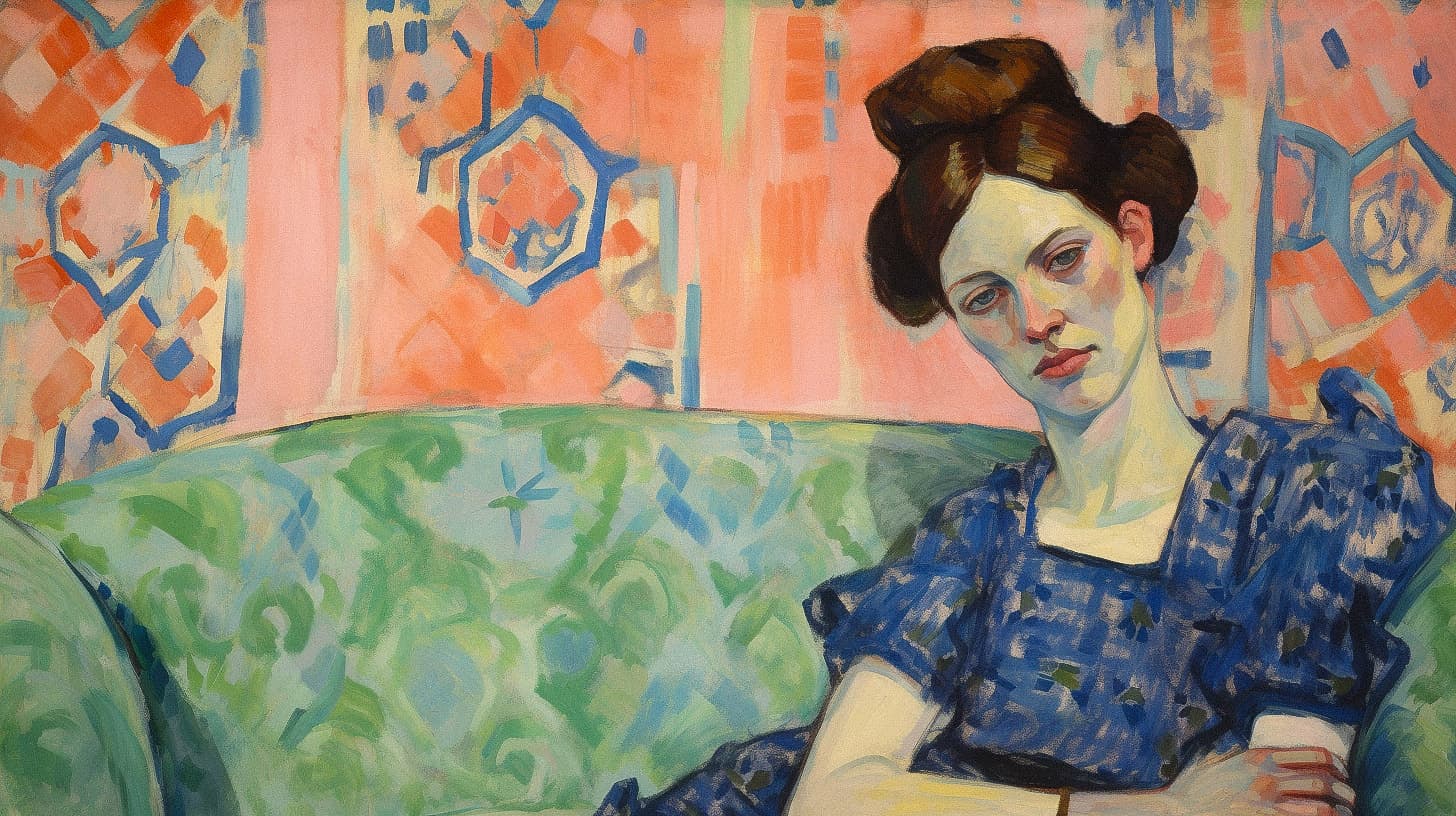Vanessa Bell (1879–1961) stands as a luminary figure in the annals of modern art, particularly within the sphere of post-impressionism. Her contributions, both as an artist and as a key member of the Bloomsbury Group, are indispensable to understanding the evolution of early 20th-century art. This article seeks to delve into the multifaceted dimensions of Bell’s oeuvre, exploring her aesthetic innovations, thematic preoccupations, and the broader cultural and intellectual currents that shaped her work.

The Genesis of an Artistic Vision
Familial and Intellectual Foundations
Born Vanessa Stephen, Bell’s early life was suffused with an intellectual vigor that would profoundly shape her artistic career. Her father, Sir Leslie Stephen, was a prominent literary figure, ensuring that the Stephen household was a nexus of cultural and intellectual activity. This environment fostered Bell’s early appreciation for the arts and her subsequent education at the Royal Academy of Arts further solidified her commitment to painting.
Encounter with Post-Impressionism
Bell’s artistic trajectory was irrevocably altered by her exposure to post-impressionism, particularly through the seminal 1910 exhibition organized by Roger Fry, “Manet and the Post-Impressionists.” This exhibition introduced British audiences to the radical works of artists such as Paul Cézanne, Vincent van Gogh, and Henri Matisse. For Bell, the exhibition represented a revelation, catalyzing a shift towards a bolder, more experimental approach to color, form, and composition.

Aesthetic Innovations: Color, Form, and Composition
Chromatic Harmonies
Bell’s use of color stands as one of her most significant contributions to post-impressionist aesthetics. Departing from the more subdued palettes of traditional British painting, Bell embraced the vibrant, expressive potential of color. Her works often feature bold, unmodulated hues that create a sense of immediacy and emotional resonance. In paintings such as “The Tub” (1917), Bell employs a palette of vivid blues and oranges, creating a dynamic interplay of color that energizes the composition.
Structural Experimentation
In addition to her innovative use of color, Bell’s approach to form and composition reflects a deep engagement with the structural innovations of post-impressionism. Influenced by Cézanne’s explorations of geometric simplification and spatial ambiguity, Bell’s compositions often deconstruct traditional perspectival space. In “Still Life on Corner of a Mantelpiece” (1914), for instance, Bell flattens the picture plane, creating a sense of spatial compression that invites the viewer to contemplate the formal relationships between objects.

Thematic Preoccupations: Domesticity and Intimacy
The Interior World
A recurrent theme in Bell’s work is the exploration of domestic interiors, which she imbues with a sense of intimacy and personal significance. These scenes often feature carefully arranged still lifes or quiet moments of domestic life, reflecting Bell’s interest in the quotidian aspects of existence. Her painting “Interior with Two Women” (1932) exemplifies this preoccupation, depicting a tranquil domestic scene that invites the viewer into a private, contemplative space.
Portraiture and the Human Condition
Bell’s contributions to portraiture are equally noteworthy, characterized by a nuanced exploration of the human condition. Her portraits often eschew detailed naturalism in favor of a more abstract, expressive approach that seeks to capture the psychological essence of her subjects. In her portrait of Virginia Woolf (1912), Bell employs bold, sweeping brushstrokes and a striking color palette to convey the intellectual intensity and emotional complexity of her sister.

The Bloomsbury Group: Interdisciplinary Synergies
A Confluence of Minds
Bell’s artistic endeavors cannot be fully understood without considering her involvement in the Bloomsbury Group, an influential collective of artists, writers, and intellectuals. The group’s commitment to exploring new forms of artistic and intellectual expression provided a fertile ground for Bell’s creative experimentation. The interdisciplinary dialogues that characterized Bloomsbury gatherings enriched Bell’s work, infusing it with a sense of intellectual rigor and cultural sophistication.
Collaborative Ventures
One of the most significant aspects of Bell’s engagement with the Bloomsbury Group was her participation in collaborative projects, such as the Omega Workshops. Founded by Roger Fry in 1913, the Omega Workshops sought to bridge the gap between fine art and decorative design, promoting the integration of artistic creativity into everyday life. Bell’s contributions to the Omega Workshops, including her designs for textiles and furniture, reflect her belief in the transformative potential of art and her commitment to aesthetic innovation.

Legacy and Influence: Vanessa Bell in Art History
Recognition and Rediscovery
Despite her significant contributions, Bell’s work was often overshadowed by that of her male contemporaries and even by other members of the Bloomsbury Group, such as her sister Virginia Woolf. However, recent scholarship has sought to re-evaluate and celebrate Bell’s contributions to modern art. This reappraisal has highlighted the originality and depth of her artistic vision, positioning her as a pivotal figure in the development of post-impressionist aesthetics.
Influence on Contemporary Artists
Bell’s legacy extends beyond her immediate historical context, influencing subsequent generations of artists. Her bold use of color, innovative compositional strategies, and thematic explorations have inspired contemporary artists who seek to challenge traditional artistic conventions and explore new aesthetic possibilities. The ongoing interest in Bell’s work attests to its enduring relevance and its capacity to inspire new forms of artistic expression.

Conclusion: Vanessa Bell’s Enduring Artistic Contribution
Vanessa Bell’s art represents a vital chapter in the history of post-impressionism, marked by her distinctive approach to color, form, and composition, and her nuanced exploration of domestic and psychological themes. Her involvement with the Bloomsbury Group and her collaborative ventures further underscore the interdisciplinary richness of her work. As contemporary scholarship continues to shed light on her contributions, Bell’s status as a seminal figure in modern art becomes increasingly clear, ensuring that her legacy will continue to inspire and inform future generations of artists and scholars.
Analyzing Key Works: A Deeper Dive into Bell’s Artistic Milestones
“The Tub” (1917): A Study in Color and Form
One of Bell’s most celebrated works, “The Tub” (1917), exemplifies her masterful use of color and form. This painting, depicting a woman bathing, is notable for its vibrant color scheme and innovative composition. Bell’s use of bold, contrasting colors not only draws the viewer’s attention but also conveys a sense of vitality and dynamism. The simplified forms and flattened perspective reflect her engagement with post-impressionist principles, while the intimate subject matter underscores her interest in the everyday moments of domestic life.
“Studland Beach” (1912): Capturing Transient Moments
In “Studland Beach” (1912), Bell captures the fleeting quality of light and atmosphere with remarkable sensitivity. This painting, which depicts a group of figures on a beach, showcases Bell’s ability to convey a sense of place and mood through her handling of color and light. The soft, diffused light and the harmonious color palette create a tranquil, contemplative scene, inviting the viewer to immerse themselves in the quiet beauty of the moment. This work highlights Bell’s ability to evoke a powerful emotional response through her nuanced use of color and composition.
“Interior with Duncan Grant” (c. 1934-35): Intimacy and Artistic Collaboration
“Interior with Duncan Grant” (c. 1934-35) is a testament to the close personal and professional relationship between Bell and fellow artist Duncan Grant. This painting, which depicts Grant seated in a domestic interior, is characterized by its warm, intimate atmosphere and its rich, vibrant color palette. Bell’s careful attention to detail and her use of color to create depth and texture reflect her deep engagement with the post-impressionist aesthetic. The painting also serves as a poignant reminder of the collaborative spirit that defined Bell’s artistic practice and her relationship with the Bloomsbury Group.

Thematic Exploration: Domestic Spaces and Intimate Moments
Reimagining Domesticity
Bell’s exploration of domestic spaces is a recurring theme in her work, reflecting her interest in the intimate, everyday aspects of life. Her paintings often depict interiors filled with personal objects, creating a sense of familiarity and warmth. These works challenge traditional notions of domesticity, presenting it not as a mundane, insignificant aspect of life, but as a rich, complex, and deeply personal realm. Bell’s ability to imbue everyday scenes with a sense of significance and emotional depth is a testament to her skill as an artist and her unique perspective on the world.
Psychological Depth in Portraiture
Bell’s portraiture is characterized by its psychological depth and its focus on capturing the essence of her subjects. Her portraits often go beyond mere physical likeness to explore the inner lives and emotional states of her sitters. This approach is evident in her portrait of Virginia Woolf, where Bell’s use of bold, expressive brushstrokes and striking color choices convey the complexity and intensity of Woolf’s character. Bell’s ability to convey psychological depth through her portraits is a testament to her skill and her deep understanding of the human condition.
The Omega Workshops: Bridging Fine Art and Decorative Design
Innovative Designs
Bell’s involvement with the Omega Workshops was a significant aspect of her artistic career, reflecting her belief in the importance of integrating art into everyday life. The Omega Workshops, founded by Roger Fry in 1913, aimed to promote the idea that art should not be confined to galleries and museums, but should be an integral part of daily living. Bell’s contributions to the Omega Workshops, including her designs for textiles, furniture, and ceramics, reflect this philosophy. Her innovative designs, characterized by their bold use of color and pattern, brought a sense of artistry and creativity to functional objects, blurring the boundaries between fine art and decorative design.
Collaborative Spirit
The collaborative nature of the Omega Workshops was a key aspect of its success, and Bell’s involvement in this venture highlights her commitment to working collaboratively with other artists. The Omega Workshops provided a space for artists to experiment with new ideas and techniques, and Bell’s contributions were a vital part of this creative exchange. Her designs for the Omega Workshops reflect her ability to translate her artistic vision into a wide range of media, demonstrating her versatility and her commitment to the idea that art should be an integral part of everyday life.

Legacy and Influence: Reassessing Vanessa Bell’s Contribution
A Pioneering Vision
Vanessa Bell’s contributions to post-impressionism and modern art have often been overshadowed by the achievements of her contemporaries. However, recent scholarship has begun to reassess her work, highlighting her pioneering vision and her significant influence on the development of modern art. Bell’s innovative use of color, her exploration of form and composition, and her focus on domestic and psychological themes have all been recognized as key contributions to the post-impressionist movement. Her work, which combines a deep understanding of post-impressionist principles with a unique personal vision, has had a lasting impact on the art world.
Inspiring Future Generations
Bell’s influence extends beyond her immediate historical context, inspiring future generations of artists. Her bold use of color, her innovative compositional strategies, and her focus on the intimate aspects of life have all resonated with contemporary artists. The ongoing interest in Bell’s work, as evidenced by numerous exhibitions and scholarly studies, attests to her enduring relevance and her capacity to inspire new forms of artistic expression. As more artists and scholars continue to explore her work, Bell’s legacy as a seminal figure in modern art will continue to grow.
Conclusion: Vanessa Bell’s Enduring Artistic Contribution
Vanessa Bell’s art represents a vital chapter in the history of post-impressionism, marked by her distinctive approach to color, form, and composition, and her nuanced exploration of domestic and psychological themes. Her involvement with the Bloomsbury Group and her collaborative ventures further underscore the interdisciplinary richness of her work. As contemporary scholarship continues to shed light on her contributions, Bell’s status as a seminal figure in modern art becomes increasingly clear, ensuring that her legacy will continue to inspire and inform future generations of artists and scholars.






